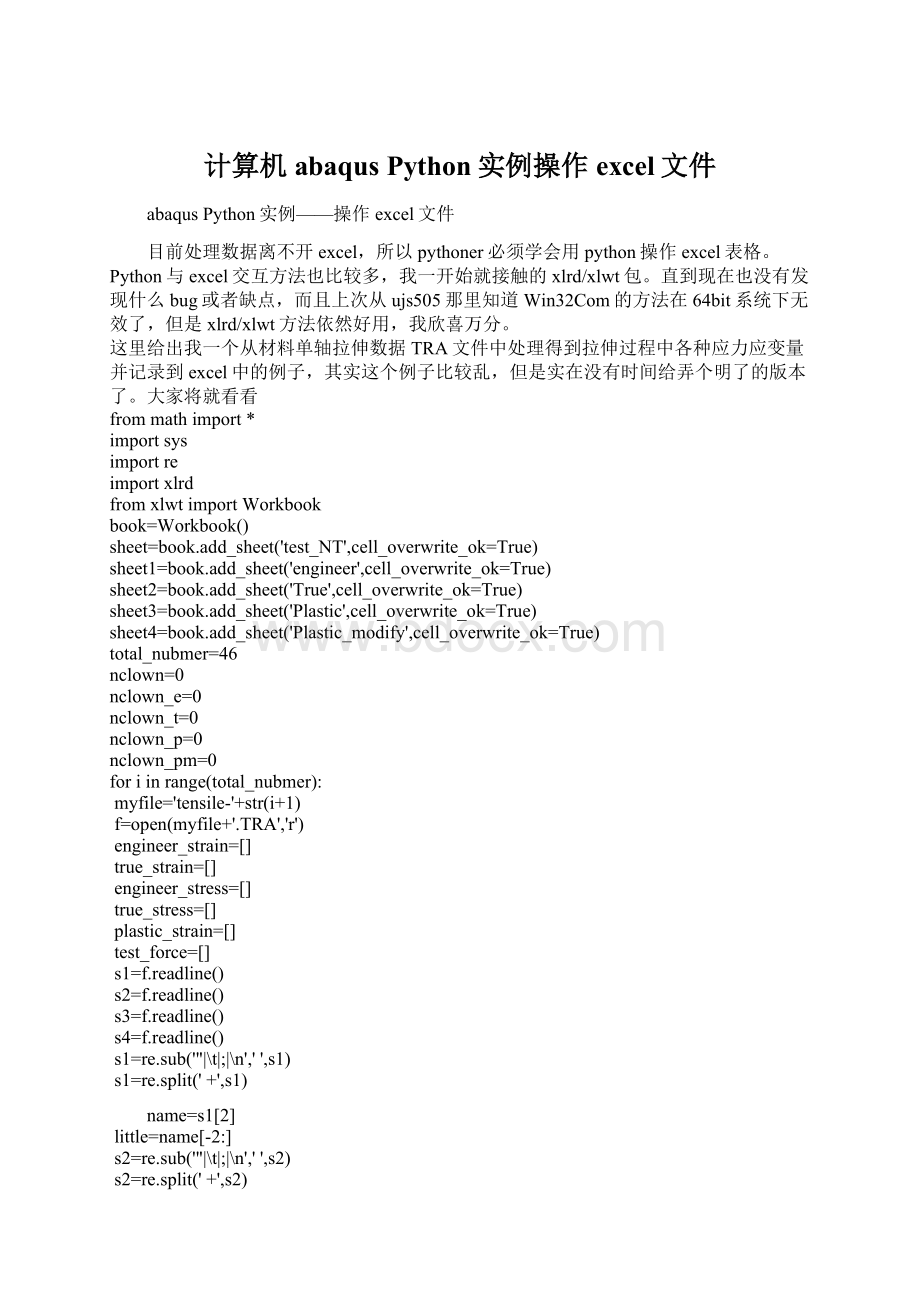计算机abaqus Python实例操作excel文件.docx
《计算机abaqus Python实例操作excel文件.docx》由会员分享,可在线阅读,更多相关《计算机abaqus Python实例操作excel文件.docx(7页珍藏版)》请在冰豆网上搜索。

计算机abaqusPython实例操作excel文件
abaqusPython实例——操作excel文件
目前处理数据离不开excel,所以pythoner必须学会用python操作excel表格。
Python与excel交互方法也比较多,我一开始就接触的xlrd/xlwt包。
直到现在也没有发现什么bug或者缺点,而且上次从ujs505那里知道Win32Com的方法在64bit系统下无效了,但是xlrd/xlwt方法依然好用,我欣喜万分。
这里给出我一个从材料单轴拉伸数据TRA文件中处理得到拉伸过程中各种应力应变量并记录到excel中的例子,其实这个例子比较乱,但是实在没有时间给弄个明了的版本了。
大家将就看看
frommathimport*
importsys
importre
importxlrd
fromxlwtimportWorkbook
book=Workbook()
sheet=book.add_sheet('test_NT',cell_overwrite_ok=True)
sheet1=book.add_sheet('engineer',cell_overwrite_ok=True)
sheet2=book.add_sheet('True',cell_overwrite_ok=True)
sheet3=book.add_sheet('Plastic',cell_overwrite_ok=True)
sheet4=book.add_sheet('Plastic_modify',cell_overwrite_ok=True)
total_nubmer=46
nclown=0
nclown_e=0
nclown_t=0
nclown_p=0
nclown_pm=0
foriinrange(total_nubmer):
myfile='tensile-'+str(i+1)
f=open(myfile+'.TRA','r')
engineer_strain=[]
true_strain=[]
engineer_stress=[]
true_stress=[]
plastic_strain=[]
test_force=[]
s1=f.readline()
s2=f.readline()
s3=f.readline()
s4=f.readline()
s1=re.sub('"|\t|;|\n','',s1)
s1=re.split('+',s1)
name=s1[2]
little=name[-2:
]
s2=re.sub('"|\t|;|\n','',s2)
s2=re.split('+',s2)
times=s2[2]
printname+'run'+str(times)
bk=xlrd.open_workbook('Staticreport.xls')
sh=bk.sheet_by_name("Stat")
diameter=sh.cell_value(i+2,4)
area=pi*((diameter)**2)/4
E_modulus=sh.cell_value(i+2,7)
state=True
s0=f.readlines()
s0=s0[-2]
s0=re.sub(';','',s0)
s0=re.split('+',s0)
f.seek(0)
s1=f.readline()
s2=f.readline()
s3=f.readline()
s4=f.readline()
whilestate:
s=f.readline()
s=re.sub(';','',s)
s=re.split('+',s)
# prints
# prints0
if(s=="EOF")|(s==s0):
state=False
else:
force=float(s[1])
eee=float(s[0])/100.0
sss=force/area
test_force.append(force)
engineer_strain.append(eee)
engineer_stress.append(sss)
true_strain.append(log(1.0+eee))
true_stress.append(sss*(1.0+eee))
plastic_strain.append(log(1.0+eee)-sss*(1.0+eee)/E_modulus)
f.close()
##########################################################3
simu_strain=[]
simu_P_strain=[]
simu_triax=[]
simu_force=[]
simu_E=204323.0
simu_little=str(int(little)+3)
simu_name="New_pass"+simu_little+"test.dat"
print'referto'+simu_name
simu_f=open(simu_name,'r')
simu_state=True
s0=simu_f.readlines()
s0=s0[-1]
s0=re.sub(';','',s0)
s0=re.split('+',s0)
# prints0
simu_f.seek(0)
simu_s1=simu_f.readline()
whilesimu_state:
simu_s2=simu_f.readline()
simu_s2=re.sub(';','',simu_s2)
simu_s2=re.split('+',simu_s2)
if(simu_s2=="EOF")|(simu_s2==s0):
simu_state=False
else:
# printsimu_s2
s_force=float(simu_s2[5])
s_eee=float(simu_s2[2])
s_triax=float(simu_s2[3])
s_sss=s_force/area
simu_force.append(s_force)
simu_triax.append(s_triax)
simu_strain.append(s_eee)
simu_P_strain.append(log(1.0+s_eee)-s_sss*(1.0+s_eee)/simu_E)
simu_f.close()
##########################################################3
nrows=3
sheet.write(0,nclown,'sample')
sheet.write(0,nclown+2,name)
sheet.write(1,nclown,"area")
sheet.write(1,nclown+2,area)
sheet.write(1,nclown+1,diameter)
sheet.write(1,nclown+3,"E_modulus")
sheet.write(1,nclown+4,E_modulus)
sheet.write(2,nclown,"E_strain")
sheet.write(2,nclown+1,"E_stress")
sheet.write(2,nclown+2,"T_strain")
sheet.write(2,nclown+3,"T_stress")
sheet.write(2,nclown+4,"PL_strain")
foriinrange(len(engineer_strain)):
sheet.write(nrows,nclown,engineer_strain[i])
sheet.write(nrows,nclown+1,engineer_stress[i])
sheet.write(nrows,nclown+2,true_strain[i])
sheet.write(nrows,nclown+3,true_stress[i])
sheet.write(nrows,nclown+4,plastic_strain[i])
nrows+=1
nclown+=5
#outputengineerstrainandstress
nrows=3
sheet1.write(0,nclown_e,'file')
sheet1.write(0,nclown_e+1,myfile)
sheet1.write(0,nclown_e+2,"E_modulus")
sheet1.write(0,nclown_e+3,E_modulus)
sheet1.write(1,nclown_e,'sample')
sheet1.write(1,nclown_e+1,name)
sheet1.write(1,nclown_e+2,'run')
sheet1.write(1,nclown_e+3,times)
sheet1.write(2,nclown_e,"E_strain")
sheet1.write(2,nclown_e+1,"E_stress")
foriinrange(len(engineer_strain)):
sheet1.write(nrows,nclown_e,engineer_strain[i])
sheet1.write(nrows,nclown_e+1,engineer_stress[i])
nrows+=1
nclown_e+=4
#outputtruestrainandstress
nrows=3
sheet2.write(0,nclown_t,'file')
sheet2.write(0,nclown_t+1,myfile)
sheet2.write(0,nclown_t+2,"E_modulus")
sheet2.write(0,nclown_t+3,E_modulus)
sheet2.write(1,nclown_t,'sample')
sheet2.write(1,nclown_t+1,name)
sheet2.write(1,nclown_t+2,'run')
sheet2.write(1,nclown_t+3,times)
sheet2.write(2,nclown_t,"T_strain")
sheet2.write(2,nclown_t+1,"T_stress")
foriinrange(len(engineer_strain)):
sheet2.write(nrows,nclown_t,true_strain[i])
sheet2.write(nrows,nclown_t+1,true_stress[i])
nrows+=1
nclown_t+=4
#outputplasticstrainandstress
nrows=3
sheet3.write(0,nclown_p,'file')
sheet3.write(0,nclown_p+1,myfile)
sheet3.write(0,nclown_p+2,"E_modulus")
sheet3.write(0,nclown_p+3,E_modulus)
sheet3.write(1,nclown_p,'sample')
sheet3.write(1,nclown_p+1,name)
sheet3.write(1,nclown_p+2,'run')
sheet3.write(1,nclown_p+3,times)
sheet3.write(2,nclown_p,"PL_strain")
sheet3.write(2,nclown_p+1,"T_stress")
foriinrange(len(engineer_strain)):
sheet3.write(nrows,nclown_p,plastic_strain[i])
sheet3.write(nrows,nclown_p+1,true_stress[i])
nrows+=1
nclown_p+=4
#outputmodifiedplasticstrainandtruestress
nrows=3
i_temp=1
sheet4.write(0,nclown_pm,'file')
sheet4.write(0,nclown_pm+1,myfile)
sheet4.write(0,nclown_pm+2,"E_modulus")
sheet4.write(0,nclown_pm+3,E_modulus)
sheet4.write(1,nclown_pm,'sample')
sheet4.write(1,nclown_pm+1,name)
sheet4.write(1,nclown_pm+2,'run')
sheet4.write(1,nclown_pm+3,times)
sheet4.write(2,nclown_pm,"PL_strain")
sheet4.write(2,nclown_pm+1,"Force")
running=True
foriinrange(len(engineer_strain)):
ifrunning:
mincr=150
temp_e=(test_force[i]-test_force[i+mincr])/(plastic_strain[i]-plastic_strain[i+mincr])
iftemp_e>400000.0:
i_temp=i
running=False
else:
modifed_strain=engineer_strain[i]-engineer_strain[i_temp]
modifed_plastic_strain=log(1.0+modifed_strain)-engineer_stress[i]*(1.0+modifed_strain)/E_modulus
sheet4.write(nrows,nclown_pm,modifed_plastic_strain)
sheet4.write(nrows,nclown_pm+1,test_force[i])
nrows+=1
##outputsimulationresult
nrows=3
sheet4.write(2,nclown_pm+2,"PL_strain")
sheet4.write(2,nclown_pm+3,"Force")
sheet4.write(2,nclown_pm+4,"TRIAX")
forjinrange(len(simu_P_strain)):
sheet4.write(nrows,nclown_pm+2,simu_P_strain[j])
sheet4.write(nrows,nclown_pm+3,simu_force[j])
sheet4.write(nrows,nclown_pm+4,simu_triax[j])
nrows+=1
#######################nextfile(Testresult)
nclown_pm+=5
book.save('material_treat.xls')
另一例子
importcsv
fromodbAccessimport*
fromabaqusConstantsimport*
filename=getInput('PleaseinputtheODBfilename')
#下面这样都是我定义的字典或list,用来存保存提取数据的
elementArea={}
elementConn={}
nodeArea ={}
timeTP =[]
#下面可以看做一般的从odb文件中提取结果的步骤
#打开指定的odb文件
odb=openOdb(path=filename)
#得到assembly中所有的instance
inst=odb.rootAssembly.instances
#或取第一个instance中的所有单元,因为我这个odb里面只有一个instance
#.keys()方法可以获得一个list有所有的instance名字
elments=inst[inst.keys()[0]].elements
#下面一段对单元循环,得到每个单元的几个结点,然后记录下来
forelinelments:
label=el.label
nodes=el.connectivity
elementConn[label]=nodes
#节点
nodes=inst[inst.keys()[0]].nodes
forndinnodes:
label=nd.label
nodeArea[label]=0
#打开指定的step
st=odb.steps[odb.steps.keys()[0]]
#对指定step的某个特定场变量做循环
forvinst.frames[-1].fieldOutputs['EVOL'].values:
label=v.elementLabel
data=v.data
elementArea[label]=data
fork,vinelementArea.iteritems():
nds=elementConn[k]
forndinnds:
nodeArea[nd]+=0.25*v
#下面是提取每个frame中每个节点的NT11值
frames=st.frames
forfrinframes:
nt11=fr.fieldOutputs['NT11'].values
time=fr.frameValue
sumTp=0
sumAr=0
forvainnt11:
label=va.nodeLabel
data=va.data
ifdata<0:
area=nodeArea[label]
sumTp+=data*area
sumAr+=area
try:
mean=float(sumTp)/float(sumAr)
timeTP.append((time,mean))
except:
printfr.frameId
filename=getInput('pleaeinputthecsvfile\nnametosave')
wr=csv.writer(file(filename,'wb'))
#这个把结果写进csv文件,只要一句,很简单,也可以在这一句之前写个表头
wr.writerows(timeTP)